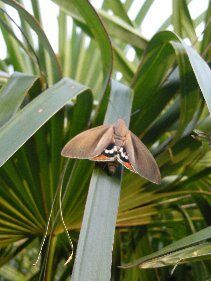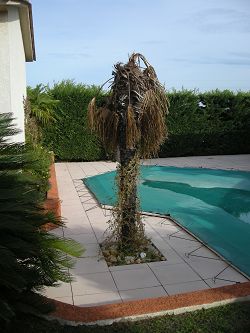The Paysandisia Archon
|
UPDATE March 2013 Han Van de Waterbeemd reports….. The situation is as follows. At the moment you can only buy vessels of 5l with the stuff and you need a compressor to apply it. This is possible but not very practical for private persons. Study is being done to come up with 1l containers, but the application still needs high pressure. However, it is important for all palm tree owners to do something this year, otherwise they risk losing their expensive palm trees and help the papillon to spread in the region. Best for this year is to use an industrial insecticide and apply four times this summer (May, June, September, October – several liters to the heart/center and top of the tree). I know very well that this is not very green, but it is for now all we have. The beast needs to be killed and its reproduction stopped! I also encourage all P-O Life readers to share experiences and knowledge via the P-O Life website. |
|
UPDATE January 2013
|
|
UPDATE 2010 Hi! It’s easy, quite cheap but for this year you need to live near Montpelier. Next year it should be easier to buy everywhere. |
 The article below originally appeared in our Local News section in August 2008. One of our readers, Anne, has since had the dubious pleasure of seeing these moths in action.
The article below originally appeared in our Local News section in August 2008. One of our readers, Anne, has since had the dubious pleasure of seeing these moths in action.
She tells us……
“This summer we saw 2 of these very pretty moths in our garden. In November we had to chop down 5 of our palm trees which had been infested.
It seems there is nothing that can be done for the moment to prevent this happening apart from netting the palm trees to stop the moths from attacking.”
The Paysandisia Archon
The Paysandisia archon, a moth believed to have been  accidentally imported from Argentina and first reported on the north Catalan coast in 2004, is responsible for munching through palm trees in Toulouges, and is gradually killing them. Palm trees have been chosen by many communes as attractive southern life ornaments to enhance village and town centres and replace the ‘platane’ or plane tree (although they are not proving to be completely suitable to the Catalan climate).
accidentally imported from Argentina and first reported on the north Catalan coast in 2004, is responsible for munching through palm trees in Toulouges, and is gradually killing them. Palm trees have been chosen by many communes as attractive southern life ornaments to enhance village and town centres and replace the ‘platane’ or plane tree (although they are not proving to be completely suitable to the Catalan climate).
This beautiful moth, which can be easily mistaken for a butterfly, is large,with dark green front wings with brown streaking, and bright red back wings with bold black and white markings.. The adults fly from June  to September and these moths are causing increasing concern in Europe due to the sometimes fatal damage to exotic palms. In fact, since arriving in the south of France in the mid-1990s, the species has spread along the Mediterranean coast to Spain and Italy and it is likely to continue spreading without effective preventative measures.
to September and these moths are causing increasing concern in Europe due to the sometimes fatal damage to exotic palms. In fact, since arriving in the south of France in the mid-1990s, the species has spread along the Mediterranean coast to Spain and Italy and it is likely to continue spreading without effective preventative measures.
Detection and control are difficult, as larvae cannot be seen or reached easily within the ‘stipe’. The larva bore through the stem or through the young leaves of the palm tree, until the palm becomes weak and can die from this. Unfortunately since this moth is not a pest in its native country, where its spread is limited by natural predators, no control method has yet been developed and it is believed that it could spread to a much larger region in the future if measures are not taken..

